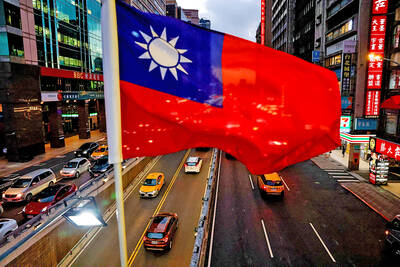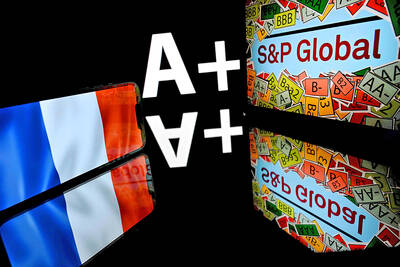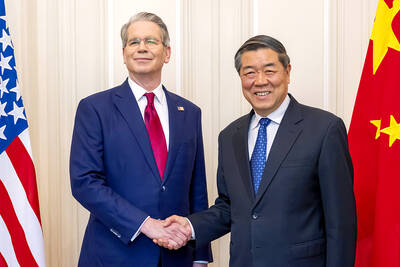Powertech Technology Inc (PTI, 力成), a memorychip tester and packager, yesterday posted better-than-expected 50 percent sequential growth in net profit for last quarter, but said this quarter would be flat due to supply constraints in DRAM chips and inventory correction on smartphone chipmakers.
Last quarter, net profit surged to NT$898 million (US$29.9 million), or NT$1.18 per share, compared with NT$597 million, or NT$0.78 a share, in the first quarter, according to a company financial statement.
Last quarter’s net income beat Credit Suisse’s estimate of NT$715 million and the consensus of NT$731 million.
“The company’s second-quarter results are better than our expectations in terms of revenue and profit after being caught in a trough for a period of time. The company is back on [the growth] track this year,” company chairman Tsai Du-kung (蔡篤恭) told investors yesterday.
Revenue this year is expected to rebound to the level recorded in 2011, when PTI generated NT$39.45 billion, as the company has fully recovered from the financial woes caused by the insolvency of its top client, Elpida Memory Inc.
Elpida filed for bankruptcy protection in February, 2012, before it was acquired by US memorychip giant Micron Technology Inc in July last year.
“We have overcome the difficulties,” Tsai said.
Orders from Elpida once accounted for 70 percent of PTI’s revenue at its peak, he said.
This quarter, revenue is expected to be flat, or slightly better than last quarter’s NT$10.58 billion, Tsai said.
He said the quarterly forecast was conservative because the tight supply of PC and mobile DRAM chips and unsustainable demand for smartphones would limit its growth momentum this quarter.
Demand for another type of memory chip, NAND flash, would continue to be robust this quarter, supported by rising demand for high-end data storage, solid-state drives (SSD) for smartphones, Tsai added.
The revenue projection fell slightly short of a 5 percent sequential growth predicted by Credit Suisse.
PTI also expects gross margin to be unchanged this quarter, compared with 17.9 percent last quarter, after an improvement from the first quarter’s 14.1 percent.
Commenting on recent speculation that Toshiba Corp may pick ChipMOS Technologies Inc (南茂科技) as its new supplier of NAND flash chip testing and packaging services, Tsai said: “The long-standing partnership between PTI and Toshiba will not be affected by such speculation.”
Toshiba and US DRAM module maker Kingston Technology Corp are PTI’s two biggest customers.
To reduce the risk of potential adverse impact from customers, PTI is managing to maintain its top client’s revenue contribution at about 30 percent.
This year, PTI plans to spend NT$7 billion on new facilities and equipment in a bid to boost capacity in advanced logic IC packaging service.

Jensen Huang (黃仁勳), founder and CEO of US-based artificial intelligence chip designer Nvidia Corp and Taiwan Semiconductor Manufacturing Co (TSMC, 台積電) on Friday celebrated the first Nvidia Blackwell wafer produced on US soil. Huang visited TSMC’s advanced wafer fab in the US state of Arizona and joined the Taiwanese chipmaker’s executives to witness the efforts to “build the infrastructure that powers the world’s AI factories, right here in America,” Nvidia said in a statement. At the event, Huang joined Y.L. Wang (王英郎), vice president of operations at TSMC, in signing their names on the Blackwell wafer to

AI BOOST: Although Taiwan’s reliance on Chinese rare earth elements is limited, it could face indirect impacts from supply issues and price volatility, an economist said DBS Bank Ltd (星展銀行) has sharply raised its forecast for Taiwan’s economic growth this year to 5.6 percent, citing stronger-than-expected exports and investment linked to artificial intelligence (AI), as it said that the current momentum could peak soon. The acceleration of the global AI race has fueled a surge in Taiwan’s AI-related capital spending and exports of information and communications technology (ICT) products, which have been key drivers of growth this year. “We have revised our GDP forecast for Taiwan upward to 5.6 percent from 4 percent, an upgrade that mainly reflects stronger-than-expected AI-related exports and investment in the third

France cannot afford to ignore the third credit-rating reduction in less than a year, French Minister of Finance Roland Lescure said. “Three agencies have downgraded us and we can’t ignore this cloud,” he told Franceinfo on Saturday, speaking just hours after S&P lowered his country’s credit rating to “A+” from “AA-” in an unscheduled move. “Fundamentally, it’s an additional cloud to a weather forecast that was already pretty gray. It’s a call for lucidity and responsibility,” he said, adding that this is “a call to be serious.” The credit assessor’s move means France has lost its double-A rating at two of the

RARE EARTHS: The call between the US Treasury Secretary and his Chinese counterpart came as Washington sought to rally G7 partners in response to China’s export controls China and the US on Saturday agreed to conduct another round of trade negotiations in the coming week, as the world’s two biggest economies seek to avoid another damaging tit-for-tat tariff battle. Beijing last week announced sweeping controls on the critical rare earths industry, prompting US President Donald Trump to threaten 100 percent tariffs on imports from China in retaliation. Trump had also threatened to cancel his expected meeting with Chinese President Xi Jinping (習近平) in South Korea later this month on the sidelines of the APEC summit. In the latest indication of efforts to resolve their dispute, Chinese state media reported that